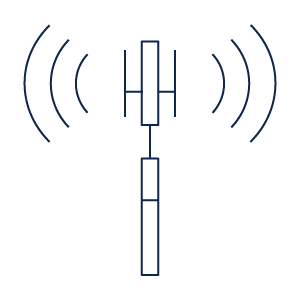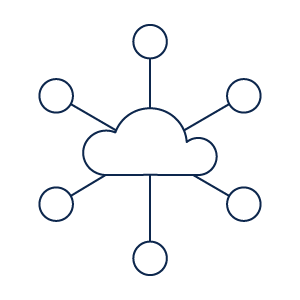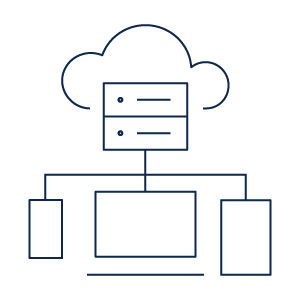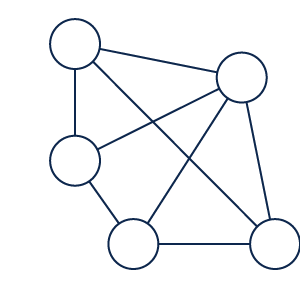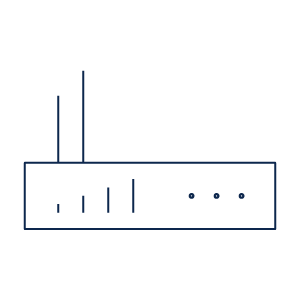Cisco Catalyst IR1101 Rugged Series Router Data Sheet
Available Languages
Bias-Free Language
The documentation set for this product strives to use bias-free language. For the purposes of this documentation set, bias-free is defined as language that does not imply discrimination based on age, disability, gender, racial identity, ethnic identity, sexual orientation, socioeconomic status, and intersectionality. Exceptions may be present in the documentation due to language that is hardcoded in the user interfaces of the product software, language used based on RFP documentation, or language that is used by a referenced third-party product. Learn more about how Cisco is using Inclusive Language.
Easily scale connectivity to remote industrial assets with this highly modular 5G router— which also gives you advanced security capabilities. The Cisco® Catalyst IR1101 Rugged Series Router or IR1101, is Cisco’s most compact, FirstNet Capable™ industrial router. Designed in a highly modular form factor makes it an ideal solution for remote asset management across multiple industrial vertical markets.
The IR1101 has an integrated 9.6 to 60V DC power input and is designed to withstand hostile environments, including shock, vibration, dust, humidity and Electrostatic Discharge (ESD). The IR1101 also supports a wide temperature range: –40 to 60°C standard operation, –40 to 75°C in a forced air enclosure with 200 LFM of air, and type-tested at 85°C for 16 hours. This durability makes it ideal for harsh industrial and distributed IoT deployments such as transportation, oil and gas, distribution substations, industrial automation, and financial institutions.
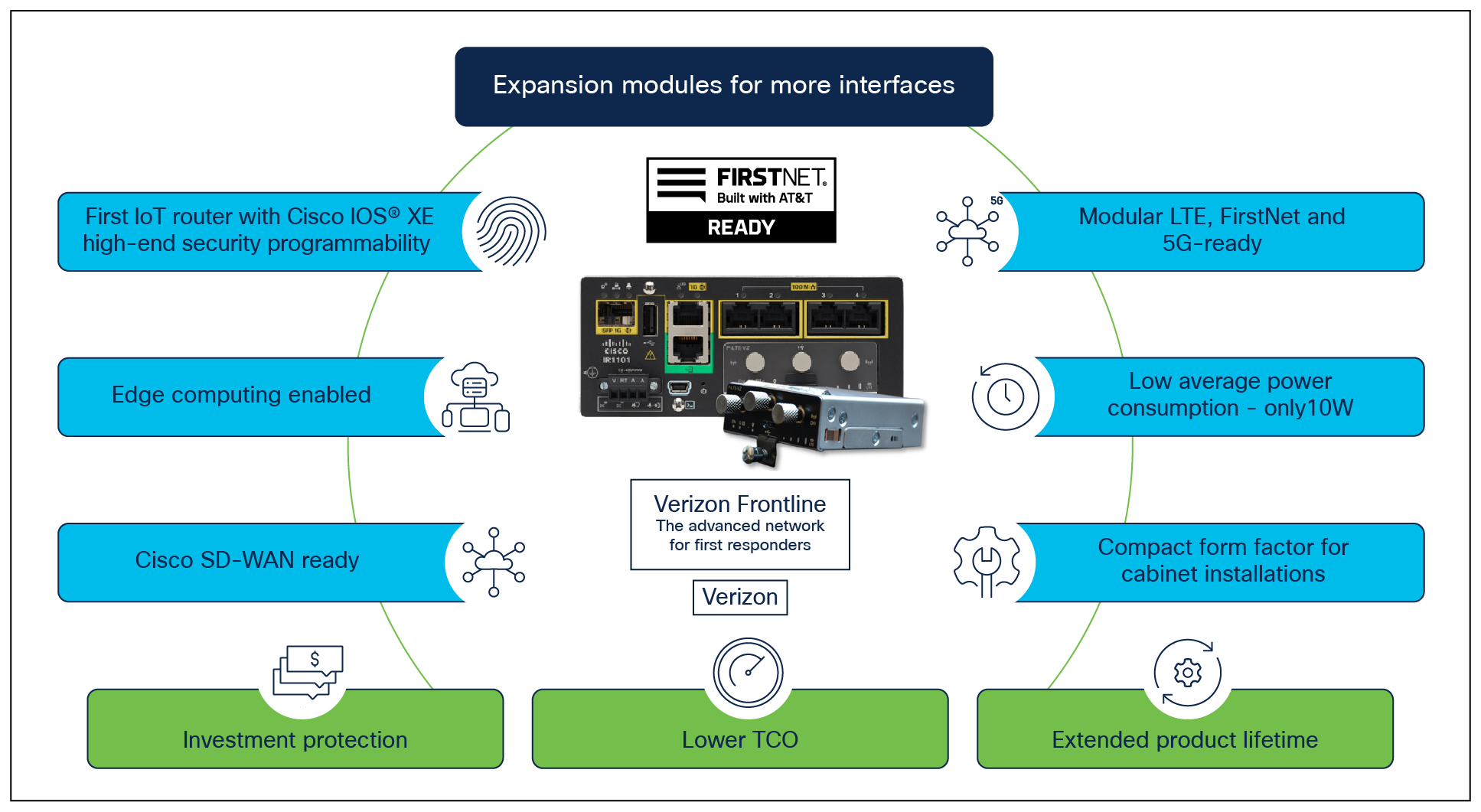
Product highlights
Figures 2, 3, and 4 offer visual views of product components and expansion modules.
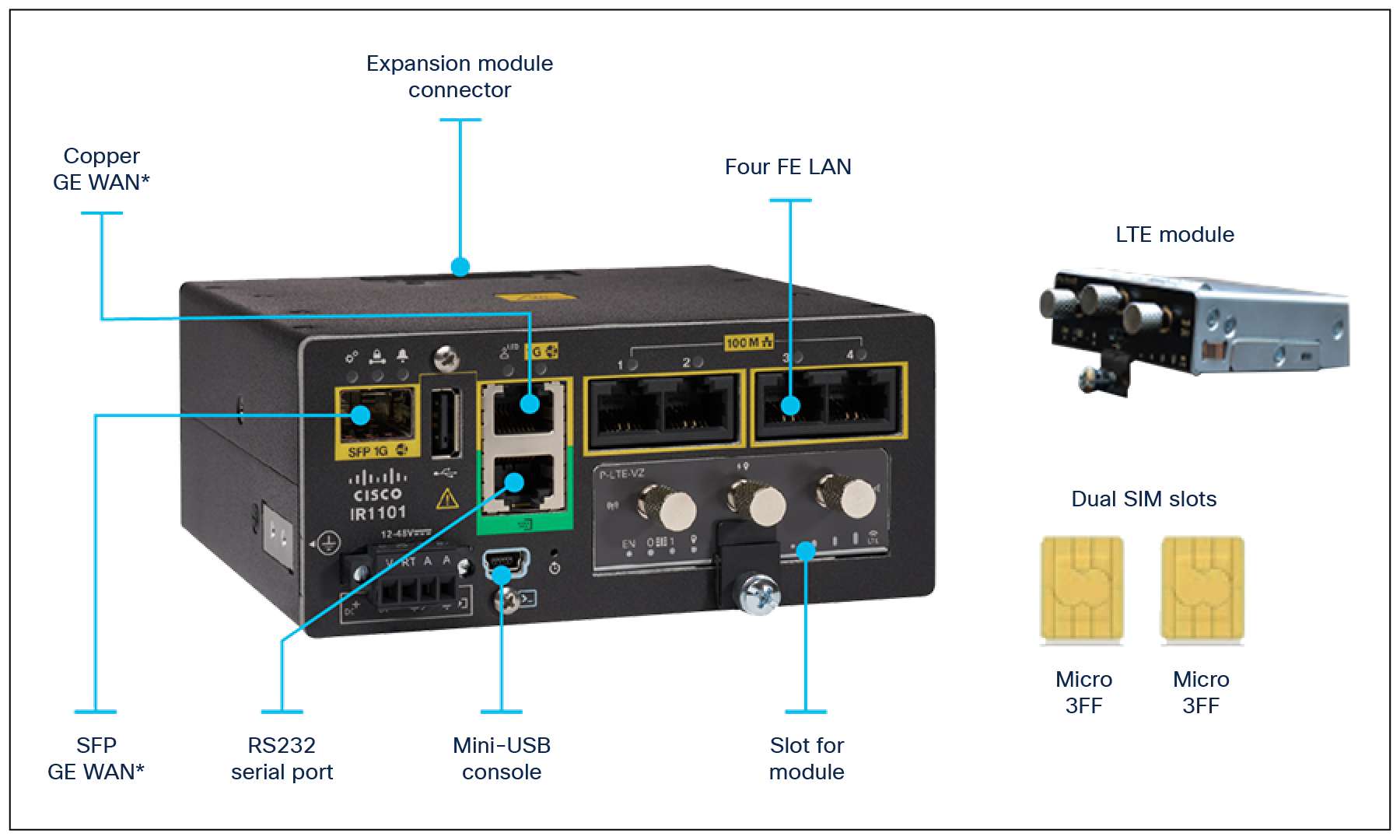
Cisco IR1101 base platform front view
The IR1101 offers even more flexibility to add or upgrade WAN and storage components through an expansion module.
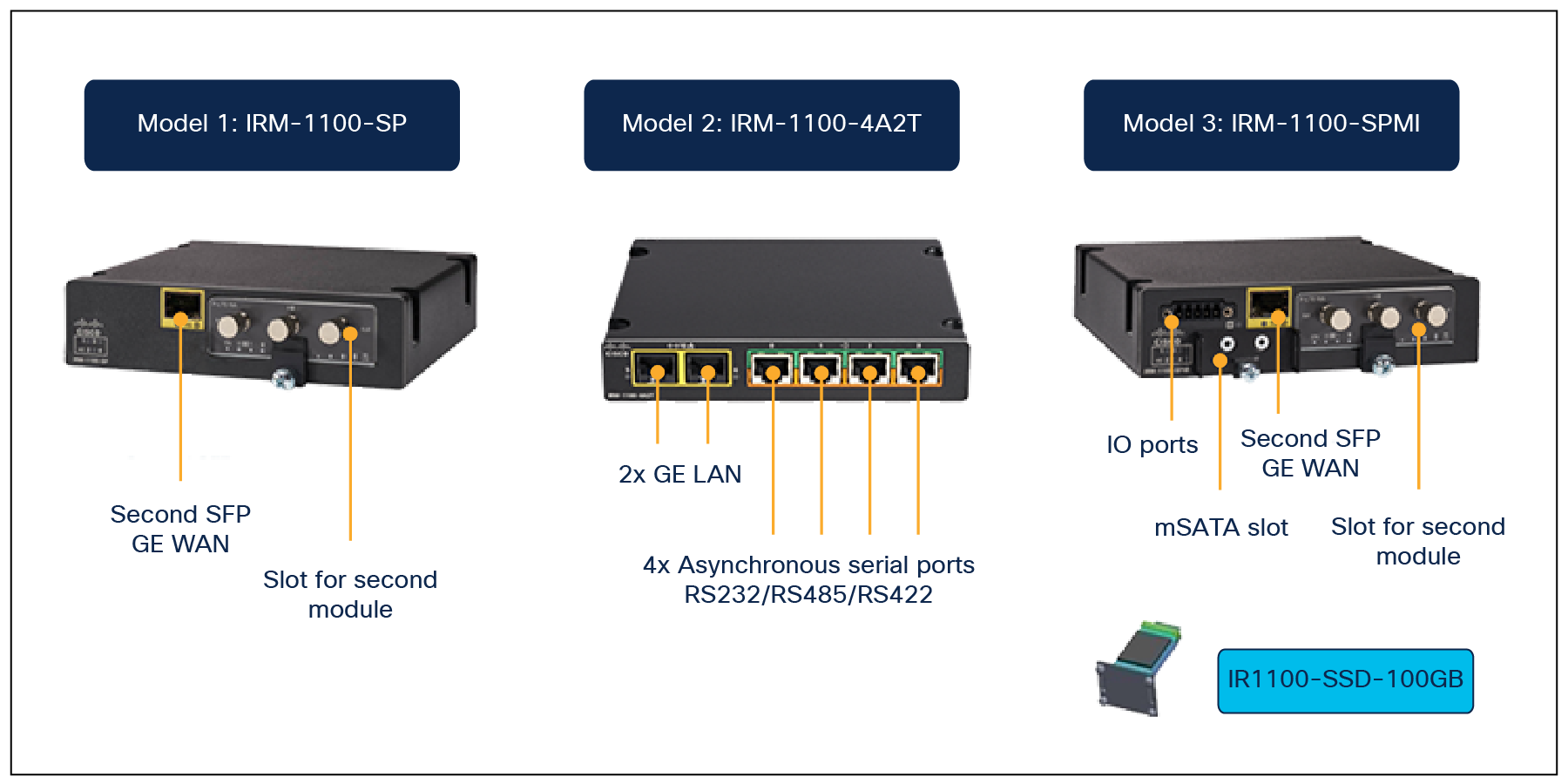
Expansion Modules
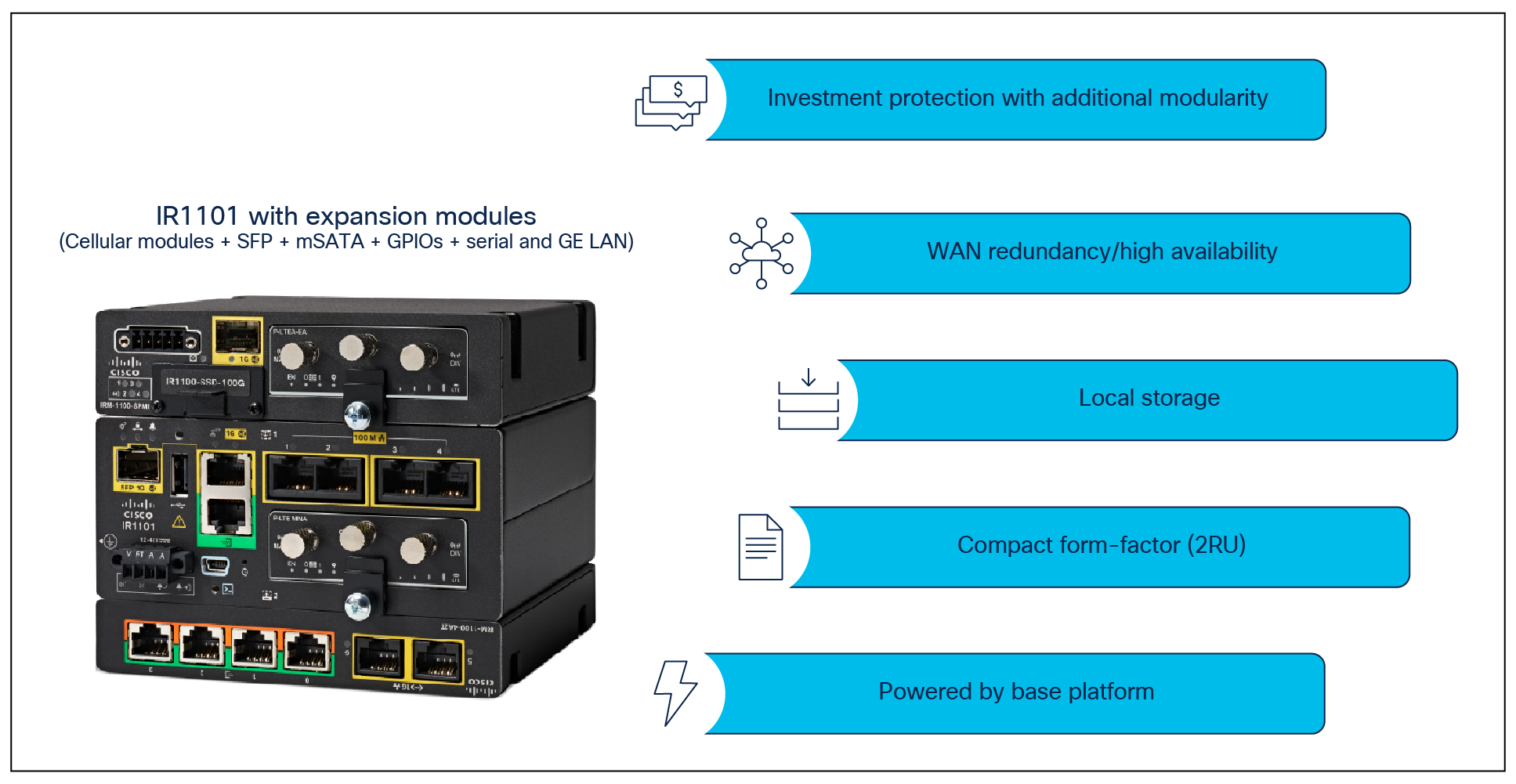
IR1101 with expansion module offering more flexibility
The Cisco Catalyst IR1101 Rugged Series Router offers a broad range of features for the Internet of Things (IoT).
Table 1. Key features and benefits
| Feature |
Benefit |
|
|
Modularity and investment protection. A single form factor with multiple WAN (LTE, LTEAdvanced, SFP Ethernet) and storage options enable flexibility to add or upgrade modules as technologies evolve. |
|
|
Dual active LTE-capable With two LTE modules (LTE and LTE-Advanced with carrier aggregation), the IR1101 enables concurrent connectivity to two cellular networks for WAN redundancy, enhanced data throughputs, load balancing, and differentiated services, making it a highly reliable and high-performance platform. |
|
|
Cisco IOS XE Software. IOS XE is a highly secure, standards-based and flexible operating system for a new era of IoT deployment. It’s an enterprise-class OS with advanced routing and security. |
|
|
Software Defined WAN (SDWAN) capable. For high WAN availability and simplicity for large-scale distributed networks. |
|
|
Industrial security. With Cisco Trust Anchor Technology ensuring authenticity of hardware and software, hardware-accelerated Next Generation Encryption and Quantum Computer Resistant algorithms, firewall and VPN services, and alerts and notifications enabling physical and cyber security, the IR1101 offers a multi-layer security for mission-critical deployments. |
|
|
Edge computing. Speed up awareness and response to events and conserve network bandwidth by analyzing the most time-sensitive data at the network edge, close to where it is generated. A highly secure, extensible environment for hosting applications ensures authenticity of applications. An optional mSATA SSD field-replaceable unit on the expansion module enables storage of application data for recording and analysis. |
|
|
Supervisory Control and Data Acquisition (SCADA). Supports migration of data from legacy control systems in an industrial environment to an IP-based network using DNP3 serial–to–DNP3/IP and IEC 60870 T101–to–T104 protocol translations. |
|
|
Smart grid-compliant. Designed for installation in harsh secondary substation environments. Complies with IEEE 1613 and IEC 61850-3 for distribution automation. |
|
|
GPS. Location-based services for tracking assets and protecting from theft and intrusion. |
|
|
Ease of management. On-premises and cloud-based network management solutions cater to businesses across multiple industry verticals. Tools such as Cisco Catalyst SD-WAN,. Cisco Catalyst Center, Cisco IoT Field Network Director (FND), simplify deployment and offer the breadth of cross-network management and the depth of multi-layer visibility. |
|
|
Multiple Packet Data Network (PDN). Gain connectivity to different Access Point Names (APNs) for traffic segregation over a cellular link. For example, public Internet traffic can be kept separate from mission-critical traffic emerging from the sensors and devices connected to the router. |
|
|
4G LTE/5G multiple-bearer QoS. Differentiated treatment of traffic with multiple simultaneous bearers as per 3GPP standards for an enhanced user experience. Multi-bearer QoS depends on the cellular carrier’s ability to support the service in their network. |
|
|
Network Segmentation. Multi-VRF, VLAN, and VPN enable businesses to configure and maintain more than one instance of a routing and forwarding table within the same customer edge device, enabling dynamic changes in the network with a minimal maintenance window. Service providers can enable this feature to support two or more VPNs with IP addresses that overlap across the VPNs. |
Business benefits and application examples
Industrial customers are looking for real-time monitoring and control of industrial assets to help increase operation efficiency.
Utilities
Utilities are seeking the capability to monitor tens of thousands of miles of electric distribution lines or water infrastructure often located in harsh environments over cellular networks to provide remote assets monitoring and reliable and secure SCADA traffic backhauling. In many cases, these are power constrained and space-constrained environments. Devices that enable this connectivity need to be highly reliable and able to be remotely monitored and configured. They also need to support traditional serial interfaces to interconnect with existing monitoring devices and fiber overlay for long-distance, intranetwork connectivity. Needless to say, the device is expected to have a long lifetime to support such a massive scale of deployment.
Oil and gas
Oil and gas companies need to monitor pipeline infrastructure across wide geographic areas and remote locations using 4G LTE and 5G cellular networks to collect data from remote terminal units and securely transport SCADA traffic to a Network Operations Center (NOC).
Transportation
Highways and transportation agencies require reliable, always-on communication between speed cameras, monitoring cameras, ticket terminals, and so on. Wireless devices to support such continuous communication need to support 4G LTE and 5G networks to help ensure good, wide coverage; continuous operation in very harsh environments; compact form factor for deployment in roadside cabinets and ticketing machines; local decision-making for a rapid response time; and serial interfaces to existing traditional devices.
Additional features and benefits
Table 2. Additional features and benefits of the Cisco IR1101
| Features |
Benefits |
| IoT enablement |
|
| Lightweight, compact, modular, and ruggedized form factor |
Designed for tight installation inside cabinets. All the Input/Output (I/O) ports and connectors are located on the front panel for easy wiring inside cabinets. |
| No additional power supply for the expansion module |
Easily add an expansion module without requiring an additional power input. |
| Raw socket transport and SCADA |
The raw socket can be used to transport SCADA data from RTUs. This method is an alternative to the Block Serial Tunnel (BSTUN) protocol. The Cisco IR1101 also supports DNP3 serial–to–DNP3/IP and IEC 60870 T101–to–IEC 60870 T104 protocol translations, serving as a SCADA gateway. |
| Multiple mounting options |
Floor or wall mounting and DIN rail mounting in horizontal or vertical orientations. |
| Increased performance to run concurrent services |
The multi-core processor architecture allows businesses to take advantage of network-supported speeds. |
| Multiple WAN and LAN connections |
|
| Four fast Ethernet interfaces |
● Allows multiple Ethernet devices (sensors, Remote Terminal Unit [RTU], PLCs) in an industrial environment to connect for visibility and management of assets
● IEEE 802.1Q VLANs
● Layer 3 support through VLAN interfaces
● 4KV isolation for Electrostatic Discharge (ESD) protection
|
| WAN diversity |
● Multiple WAN links for high reliability: Gigabit Ethernet layer 3 SFP (copper and fiber) and 4G LTE/5G provides WAN diversity and business continuity
● Gigabit Ethernet WAN interface can be configured for layer 3 routing or layer 2 switching
|
| Dual active LTE interfaces |
Concurrent connectivity to two cellular networks for high reliability, load balancing, and differentiated services. |
| Serial interface |
A RS-232 asynchronous serial interface (RJ45 DTE) can be used with raw socket, protocol translation, and connections to locate Remote Terminal Unit (RTU), sensors, and PLCs for SCADA transport and management. |
| Transparent roaming between wireless networks |
|
| Dual Subscriber-Identity-Module (SIM) over cellular |
Provides active and backup connectivity for high reliability over LTE and HSPA networks. |
| Cisco IOS® mobile IP |
● Transparent roaming for mobile networks, enabling mission-critical applications to stay connected, even when moving between networks
● The assigned IP addresses to the home network are maintained in private and public networks
● Supports Proxy Mobile IP (PMIPv6) and Network Mobility (NEMO)
|
| Cellular fallback |
Multiple technologies (5G, 4G LTE, 3G, and 2G) are available to support connectivity to the best one available. 2G fallback is not supported in North America. |
| Software |
|
| Cisco IOS XE |
Designed to enable businesses to deploy services more quickly with lower TCO and complexity.
● Openness and programmability: Standards-based programmable interfaces enable process and workflow automation. NETCONF, RESTCONF, IETF YANG, Python scripting, and custom libraries enable automation of event-based workflows
● Secure: Multi-level, end-to-end security and trust are built in. The built-in Cisco Next Generation Encryption and Quantum Computing Resistant algorithms are expected to meet security and scalability requirements for the next two decades
● Modular: Enables patching of software bug fixes and graceful insertion and removal of software modules for ease of maintenance
● Common software stack: Reduces business and network complexity while managing an array of Cisco devices
|
Table 3. Network management solutions
| Operational phase |
Application |
Description |
| Device staging and configuration for a few routers |
Cisco WebUI |
● A GUI-based device-management tool that simplifies provisioning of devices for a small-scale deployment through easy-to-use wizards.
|
| Deploy, manage, monitor, and maintain IoT routers and assets at scale |
Cisco IoT Field Network Director (FND) for hosting on premises |
● Rapid scaling - zero-touch deployment and secure enrollment for tens of thousands of gateways
● Enhanced security – role-based access and user audit trail and secure communications for data transport across networks, VPN tunnels, geo-fencing, alerts, and notifications for data and physical security
● Increased reliability – reliable communications over cellular or Ethernet networks, lifecycle management, and 24/7 real-time monitoring and alerts
|
| Extend your enterprise network to configure, monitor, and manage industrial assets |
Cisco Catalyst Center or Cisco Catalyst SD- WAN Manager |
● Cisco Catalyst Center offers a network infrastructure that is not only fully programmable and open to third–party innovation, but can also fully and seamlessly integrate the cloud as an infrastructure component
● Simplifies and automates processes and workflow by bringing the notion of user-aware and application–aware policies into the foreground of network operations
● With Cisco Catalyst Center, the network can provide continuous feedback to simplify and optimize network operations
● Single management dashboard for configuration and management of WAN, that includes advanced security capabilities.
● Cisco SD-WAN automates application flexibility over multiple connections, such as the Internet, MPLS, and wireless 4G LTE/5G
|
Table 4. Embedded management capabilities
| Feature |
Description |
| Cisco IOS Embedded Event Manager (EEM) |
A distributed and customized approach to event detection and recovery. Provides the ability to monitor events and take corrective or any other desired action when the monitored events, such as a high or low threshold, occur. |
| Cisco IOS XE IP Service- Level Agreements (IP SLA) |
Helps assure the performance of new, business-critical IP applications as well as IP services by actively monitoring and reliably reporting traffic statistics such as jitter, response time, packet loss, and connectivity. |
| Simple Network Management Protocol (SNMP), Syslog, NetFlow |
Open-standards-based network monitoring and accounting tools, such as SNMP for 3G, 4G and, provide a common management platform for many different devices. |
| LTE network management and diagnostics |
A dedicated diagnostic port on a cellular module enables logging of data during debugging sessions that can be analyzed by industry-standard tools such as Qualcomm CDMA Air Interface Tester (CAIT) and Spirent Universal Diagnostic Monitor (UDM). |
Table 5. Cisco IOS XE Software Features on the IR1101
| Feature |
Description |
| Cisco IOS Software requirements |
● Cisco IOS XE Software: Universal Cisco IOS Software image
● Cisco IOS XE Software Release 16.10.1 or later
|
| IPv4 and IPv6 services features |
● Routing Information Protocol Versions 1 and 2 (RIPv1 and RIPv2)
● Generic Routing Encapsulation (GRE) and Multipoint GRE (MGRE)
● Standard 802.1d Spanning Tree Protocol (STP)
● Network Address Translation (NAT)
● Dynamic Host Configuration Protocol (DHCP) server, relay, and client
● Dynamic DNS (DDNS)
● DNS proxy
● DNS spoofing
● Access Control Lists (ACLs)
● IPv4 and IPv6 multicast
● IP Service-Level Agreement (IP SLA)
● Open Shortest Path First (OSPFv2 and OSPFv3)
● Border Gateway Protocol (BGP)
● Enhanced Interior Gateway Routing Protocol (EIGRP)
● Virtual Route Forwarding (VRF) Lite
● Next-Hop Resolution Protocol (NHRP)
● Serial data encapsulation and relay
● L2TPv3 over sub-interfaces and VLAN
|
| Security features |
Secure connectivity
● Secure Sockets Layer (SSL) VPN for secure remote access
● Hardware-accelerated encryption with minimal impact to system performance
● Next Generation Encryption (NGE) and Quantum Computing Resistant (QCR) algorithms such as AES-256, SHA-384, and SHA-512
● Public-Key-Infrastructure (PKI) support
● IPsec tunnels
● NAT transparency
● Dynamic Multipoint VPN (DMVPN)
● Tunnel-less Group Encrypted Transport VPN
● Flex VPN
● IPsec stateful failover
● VRF-aware IPsec
● IPsec over IPv6
Cisco IOS-XE Application Aware Firewall
● Zone-based policy firewall
● VRF-aware stateful inspection routing firewall
● Stateful inspection transparent firewall
● Advanced application inspection and control
● Secure HTTP (HTTPS), FTP, and Telnet Authentication Proxy
● Dynamic and static port security
● Firewall stateful failover
● VRF-aware firewall
Integrated Threat Control
● Control-Plane Policing (CoPP)
● Flexible packet matching
● Network foundation protection
|
| QoS features |
● Provides LTE QoS with support for up to 8 concurrent bearers on each cellular WAN interface for traffic classification and prioritization
● Provides traffic precedence to delay-sensitive and mission-critical services
● Facilitates low-latency routing of delay-sensitive industrial applications
● Supported on all LAN and WAN interfaces, including cellular
● Low Latency Queuing (LLQ)
● Weighted Fair Queuing (WFQ)
● Class-Based WFQ (CBWFQ)
● Class-Based Traffic Shaping (CBTS)
● Class-Based Traffic Policing (CBTP)
● Policy-Based Routing (PBR)
● Class-Based QoS MIB
● Class of Service (CoS) to Differentiated Services Code Point (DSCP) mapping
● Class-Based Weighted Random Early Detection (CBWRED)
● Resource Reservation Protocol (RSVP)
● Real-Time Transport Protocol (RTP) header compression (cRTP)
● Differentiated Services (DiffServ)
● QoS pre-classify and pre-fragmentation
● Hierarchical QoS (HQoS)
|
| High-availability features |
● Dual active LTE backhaul with expansion module
● Virtual Router Redundancy Protocol (VRRP) (RFC 2338)
● Hot Standby Router Protocol (HSRP)
● Dual SIM support on the LTE module for cellular failover
|
| IPv6 features |
● IPv6 addressing architecture
● IPv6 unicast and multicast forwarding
● IPv6 ACLs
● IPv6 over cellular
● IPv6 routing
● IPv6 domain name resolution
|
The IR1101 offers two software tiers - network Essential and Network Advantage. The Network Essential license offers the essential elements of routing and security necessary for typical IoT deployments. The Network Advantage license enables advanced features, including Multiprotocol Label Switching (MPLS) for a highly scalable and cost-effective solution; mobile IP for seamless migration between networks; and application-aware QoS policies for built-in intelligence. The Network Advantage license also entitles users to Cisco Edge Intelligence, starting in EI Release 2.0.
A single Cisco IOS XE universal image encompassing all functions gets delivered with the product. Software feature licenses are pre-installed in the factory depending on the selection made at the time of purchase, thereby simplifying software delivery and decreasing operational costs of the deployment.
Licenses can be upgraded after deployment by going through the Cisco Smart License activation process. For a more detailed overview on Cisco Licensing, go to cisco.com/go/licensingguide.
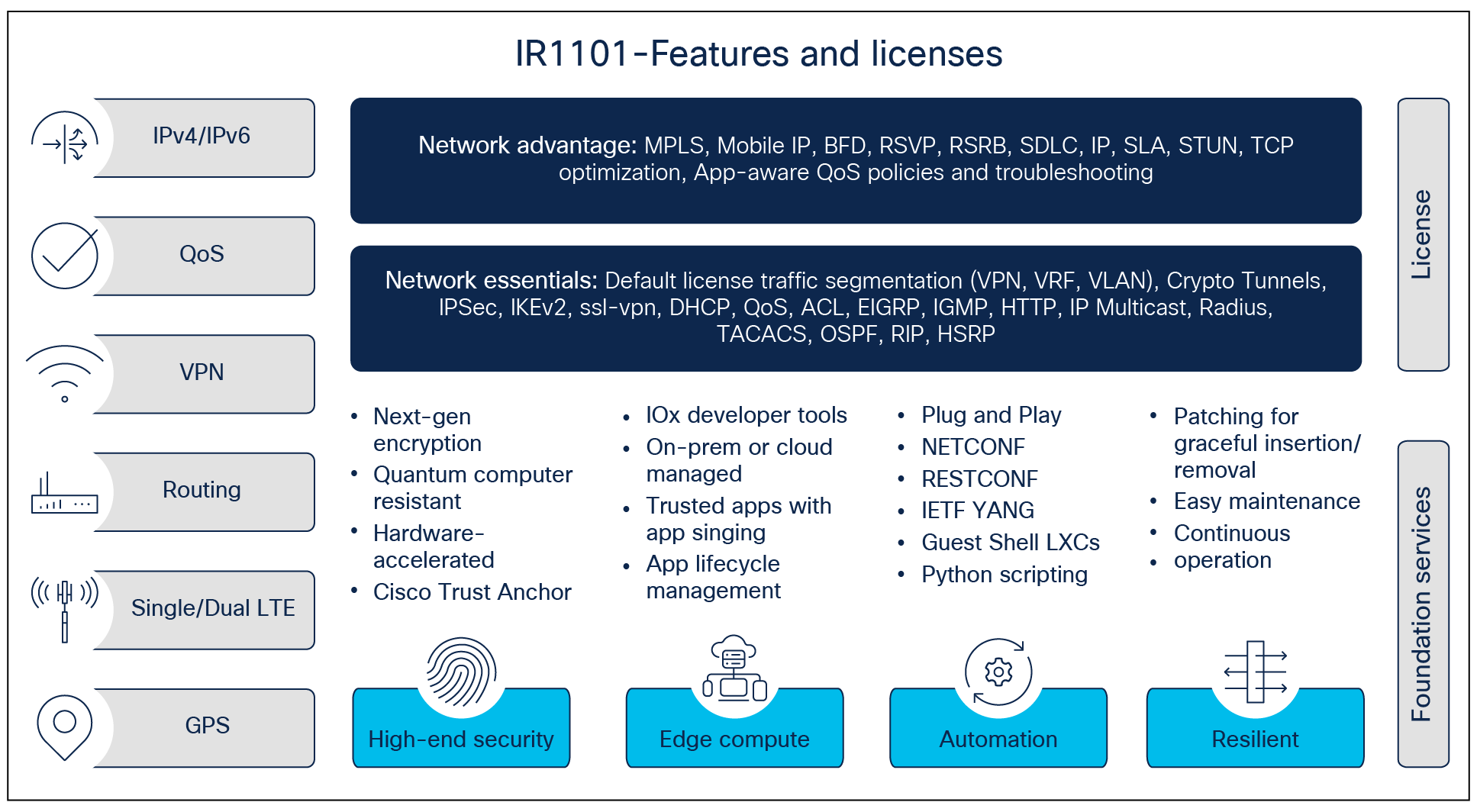
Cisco IOS XE software features and benefits
Table 6. System specifications for Cisco Catalyst IR1101 Rugged Series Router
| Feature |
Specification |
| Memory |
|
| Default and maximum DRAM |
4 GB |
| Default and maximum Flash memory |
4 GB (usable) |
| Ingress protection rating |
IP30 |
| Physical characteristics |
|
| Physical dimensions (H x W x D) Chassis Expansion Module (IRM-1100-SP or IRM-1100-SPMI) Expansion Module (IRM-1100-4A2T or IRM-1100-4S-8I) |
2.36 in. x 5.22 in. x 4.92 in. (60 x 132.5 x 124.9 mm)
1.3 in. x 5.2 in. x 4.9 in. (33 x 132 x 124 mm) 0.9 in. x 5.2 in. x 4.9 in. (23 x 132 x 124 mm) |
| Weight Chassis Expansion Module IRM-1100-SPMI: IRM-1100-SP: IRM-1100-4A2T or IRM-1100-4S8I |
2.25 lbs (1.02 kg)
1.65 lbs (0.75 kg) 1.45 lbs (0.66 kg) 0.94 lbs (0.43 kg) |
| Mounting options |
Panel, wall, and din rail (vertical and horizontal) mount |
| Power specifications |
Nominal voltage: +/-12V to +/-48V DC Minimum and maximum input voltage: 9.6-60V DC Maximum and minimum input current: 1.24A (9.6V DC) and 0.26A (60V DC) |
| Power consumption |
At idle: 6.6W Typical: 9.8W Maximum: 12W Additional 10W (typical) with expansion module and 2nd cellular |
| Interfaces on the base platform |
|
| Console |
Mini type-B USB |
| WAN interfaces |
● Combo 10/100/1000 Gigabit Ethernet port (RJ45 and SFP) on the base platform
● An additional 10/100/1000 Gigabit Ethernet SFP on the expansion module. Refer to Table 8 for supported SFPs
● 5G/LTE: Modular with options for single and dual active LTE and LTE-Advanced
|
| LAN interfaces |
● Four 10/100BASE-T Fast Ethernet ports |
| Input and output |
● ALARM input port |
| Interfaces on Serial and Ethernet Expansion Module |
|
| Serial Interfaces |
● 4 x Isolated asynchronous serial ports (RS232/RS485/RS422)(DCE) |
| Ethernet Interfaces |
● 2 x GE RJ45 LAN ports on serial expansion module |
| LEDs |
● System OK
● Link for Ethernet WAN ports
● VPN
● Tricolor user-configurable LED
● ALARM
|
| Serial interface |
● Isolated RS-232 RJ45 DTE port
● Support for asynchronous mode with speeds up to 115,200 baud
|
| Serial protocols |
SCADA, DNP3, T101-104, Raw Socket TCP, and UDP |
| Interfaces on SFP and GPIO Expansion Module |
|
| SFP Interfaces |
●
4 x GE L2/L3 SFP ports
|
| GPIO Interfaces |
● 8 x dry/wet contact GPIO ports
|
| Environmental characteristics |
|
| Environmental operating temperature range |
–40 to 140°F (–40 to 60°C) in a sealed NEMA cabinet with no airflow –40 to 158°F (–40 to 70°C) in a vented cabinet with 40 Linear Feet per Minute (LFM) of air –40 to 167°F (–40 to 75°C) in a forced air enclosure with 200 LFM of air Type tested at 85°C for 16 hours |
| Operating altitude |
40°C up to 13,800 ft (operating) per IEC 68-2-41 |
| Non-operating temperature |
-40 to 185°F (-40 to 85°C) |
| Non-operating shock and vibration |
● 50-60G (3.76 m/s minimum)
● 3-500Hz at 1.12 GRMS (BP at 10 and 100 Hz)
|
| Standard safety certifications |
● UL 60950-1, 2
nd edition
● CAN/CSA C22.2 No. 60950-1, 2
nd edition
● EN 60950-1, 2
nd edition
● CB to IEC 60950-1, 2
nd edition with all group differences and national deviations
|
| Hazardous locations standards |
● ANSI/ISA 12.12.01 (Class 1, Div 2 A-D)
● CSA 213 (Class 1, Div 2 A-D)
● IEC 60079-0 and -15 IECEx test report (Class I, Zone 2, gas groups IIC)
● EN 60079-0 and -15 ATEX certification (Class I, Zone 2, gas groups IIC)
|
| Industry standards |
Public Safety:
● FirstNet Capable
™
● Verizon Frontline
Smart Grid:
● IEC 61850-3
● IEEE 1613
Railway:
● EN 50121-4 Security:
● FIPS 140-2
● Common Criteria
Department of Defense
● DoDIN APL
IPv6
● USGv6
|
| EMC emissions CLASS A |
● 47 CFR Part 15 B
● EN 55032:2015
● CISPR 32 Edition 2
● CNS13438: 2006
● EN 300 386 V1.6.1
● ICES-003 Issue 6: 2016
● KN 32: 2015
● TCVN 7189: 2009
● V-2/2015.04
● V-3/2015.04
● AS/NZ CISPR32
|
| EMC immunity |
● EN 61000-4-2, 3, 4, 5, 6, 8, 9, 16, 17, 18, and 29
● CISPR24: 2010 + A1: 2015
● EN 300 386 V1.6.1
● EN 55024: 2010 + A1: 2015
● EN 55035:2017
● KN35: 2015
● TCVN 7317:2003
● QCVN 18:2014
|
Table 7. LTE (3GPP Category 4) Modules Available with IR1101
| Features |
P-LTE-MNA |
P-LTE-VZ |
P-LTE-US |
P-LTE-GB |
| Countries/Regions |
United States, Canada, North America |
United States |
United States |
Europe |
| LTE Bands |
LTE Bands B2, B4, B5, B12, B13, B14, B17, B66 FDD LTE 1700 MHz and 2100 MHz (B66 Ext AWS), 700 MHz (B17, B14, B13, B12), 850 MHz (B5 CLR), 1700 MHz and 2100 MHz (B4 AWS), 1900 MHz (B2) |
LTE Bands B4, B13 FDD LTE 700 MHz (B13), 1700 MHz and 2100 MHz (B4 AWS) |
LTE Bands B2, B4, B5, B12 FDD LTE 700 MHz (B17), 700 MHz (B12), 850 MHz (B5 CLR), 1700 MHz and 2100 MHz (B4 AWS) |
LTE Bands B1, B3, B7, B8, B20, B28 FDD LTE 700 MHz (B28), 800 MHz (B20), 900 MHz (B8), 1800 MHz (B3), 2100 MHz (B1), and 2600 MHz (B7) |
| Backward Compatibility |
UMTS, HSPA+ (B2, B4, B5) |
- |
HSPA+ (B2, B4, B5) |
UMTS, HSPA+ (B1, B8), EDGE, GSM, GPRS (900/1800) |
| Theoretical Download and Upload Speeds1 |
150 Mbps/50 Mbps |
150 Mbps/50 Mbps |
150 Mbps/50 Mbps |
150 Mbps/50 Mbps |
| Carrier(s) Certified |
US - AT&T, Verizon, PTCRB6 |
US - Verizon |
US - AT&T |
Europe - Generic Carrier Firmware (GCF) |
| FirstNet Capable™ (B14) |
Approved by AT&T FirstNet |
- |
- |
- |
Table 8. LTE (3GPP Category 4) Modules Available with IR1101
| Features |
P-LTE-IN |
P-LTE-JN |
| Countries/Regions |
India |
Japan |
| LTE bands |
LTE Bands B1, B3, B5, B8, B40, B41* FDD LTE 2100 MHz (B1), 1800MHz (B3), 850MHz (B5), 900MHz (B8) TDD LTE 2300 MHz (B40), 2500MHz (B41). *B41 supported frequency range: (2535–2655 MHz) |
LTE Bands B1, B3, B8, B11, B18, B19, B21 FDD LTE 2100 MHz (B1), 1800MHz (B3), 900Mhz (B8), 1500MHz (B11), 850MHz (B18, B19), 1500MHz (B21) |
| Backward Compatibility |
HSPA+, UMTS (B1, B8) |
HSPA+, UMTS (B1, B6, B19) |
| Theoretical Download and Upload Speeds1 |
150 Mbps/50 Mbps |
150 Mbps/50 Mbps |
| Carrier(s) |
India - Generic Carrier Firmware (GCF) |
Japan - NTT Docomo, KDDI, Softbank |
Table 9. LTE Advanced (3GPP Category 7) Modules Available with IR1101
| Features |
P-LTEA7-NA |
P-LTEA7-EAL |
P-LTEA7-JP |
| Countries /Regions |
United States, Canada, North America |
Europe, LATAM, Australia, New Zealand, India, Singapore, Malaysia, United Arab Emirates |
Japan |
| LTE Bands |
B2, B4, B5, B7, B12, B13, B14, B25, B26, B41, B42, B43, B48, B66, B71 |
B1, B3, B7, B8, B20, B28, B32, B38, B40, B41, B42, B43 |
B1, B3, B5, B8, B18, B19, B39, B41, B42, B43 |
| 3G HSPA+ Bands |
B2, B4, B5 |
B1, B5, B8 |
B1, B5, B6, B19 |
| Theoretical Download and Upload Speeds1 |
300 Mbps/150Mbps |
300 Mbps/150Mbps |
300 Mbps/150Mbps |
| Carrier(s) Certified |
US - Verizon, AT&T, T-Mobile, PTCRB6 Canada – Rogers |
LATAM, Europe, APJC - Generic Carrier Firmware (GCF) |
- |
| Carrier(s) Coming Soon |
Canada - Bell, Telus |
Australia - Telstra |
NTT Docomo, KDDI, Softbank |
| FirstNet Capable™ (B14) |
Approved by AT&T FirstNet |
- |
- |
Table 10. Standalone/Non-Standalone 5G Sub 6 GHZ Module Available with IR1101
| Features |
P-5GS6-R16SA-GL5 |
| Countries/Regions |
United States, Canada, LATAM, Europe, Australia, New Zealand, Japan, Hong Kong, Indonesia, Singapore, India, China |
| RF Bands |
5G FR1 n1, n2, n3, n5, n7, n8, n12, n13, n14, n18, n20, n25, n26, n28, n29-n30, n38, n40, n41, n48, n66, n70, n71, n75, n76, n77, n78, n79 LTE Bands B1, B2, B3, B4, B5, B7, B8, B12, B13, B14, B17, B18, B19, B20, B25, B26, B28, B29, B30, B32, B34, B38, B39, B40, B41, B42, B43, B46 (LAA), B48 (CBRS), B66, B71 |
| Theoretical Download and Upload Speeds1 |
4.9 Gbps/660 Mbps |
| Carrier(s) Certified |
US - AT&T, Verizon, T-mobile, PTCRB6 LATAM, Europe, APJC - Generic Carrier Firmware (GCF) |
| Carrier(s) Coming Soon |
Canada - Bell, Telus, Rogers Australia - Telstra Japan - NTT Docomo, KDDI |
| FirstNet Capable™ (B14) |
Approved by AT&T FirstNet |
Table 11. 5G Sub 6 GHZ Module Available with IR1101
| Features |
P-5GS6-GL |
| Countries/Regions |
United States, Canada, LATAM, Europe, Australia, New Zealand, Japan, Hong Kong, Indonesia, Singapore, India, China |
| RF Bands |
5G FR1 n1, n2, n3, n5, n7, n8, n12, n13, n14, n18, n20, n25, n26, n28, n29-n30, n38, n40, n41, n48, n66, n70, n71, n75, n76, n77, n78, n79 LTE Bands B1, B2, B3, B4, B5, B7, B8, B12, B13, B14, B17, B18, B19, B20, B25, B26, B28, B29, B30, B32, B34, B38, B39, B40, B41, B42, B43, B46 (LAA), B48 (CBRS), B66, B71 |
| Theoretical Download and Upload Speeds1 |
3.3 Gbps/400 Mbps |
| Carrier(s) Certified |
US - AT&T, Verizon, T-mobile, PTCRB6 Canada - Bell, Telus, Rogers Japan - NTT Docomo, KDDI Australia - Telstra LATAM, Europe, APJC - Generic Carrier Firmware (GCF) |
| FirstNet Capable™ (B14) |
Approved by AT&T FirstNet |
Extending connectivity to remote sites can be challenging, especially when connectivity requirements differ depending on location and use case. As organizations are automating and establishing remote operations, Cisco is expanding the capabilities of the Catalyst IR1100 Rugged Series Router (1101-A-K9 only) to meet the connectivity requirements of businesses wherever they operate. Network Advantage license is required.
Cellular communications in the 400-450MHz band, also called 450MHz LTE, have a longer wavelength, lower frequency and lower energy requirements compared to the traditional LTE and 5G. Due to the physical properties of the frequencies, it has benefits of covering a larger geographical area. It has been employed across several parts of Europe for connecting utility grids, maritime and other mission critical networks.
Cisco has partnered with Intelliport, a Hungary based technology provider in developing a module for the IR1101 to meet the market needs. The 450MHz LTE band provides high resiliency and deep indoor signal penetration to connect the Catalyst IR1101 anywhere onsite. Datasheet for the module is available here - https://www.intelliport.hu/dinamic/P-LTE-450%20datasheet%20v1dot0.pdf.
Cisco Small Form-Factor Pluggable (SFPs) modules
The IR1101 Ethernet SFP module provides connections to other devices. These field-replaceable transceiver modules provide the uplink interfaces. Local connectors provide the fiber-optic connection. RJ-45 connectors allow for copper connections.
Table 12. Supported Ethernet SFP modules
| GE SFP |
Distance |
Fiber |
Classification |
| GLC-SX-MM-RGD |
220-550 m |
MMF |
Industrial (-40C to +85C) |
| GLC-LX-SM-RGD |
550m/10 km |
MMF/SMF |
Industrial (-40C to +85C) |
| GLC-ZX-SM-RGD |
70 km |
SMF |
Industrial (-40C to +85C) |
| GLC-SX-MMD |
220-550m |
MMF |
Extended (-5C to +85C) |
| GLC-LH-SMD |
550m/10 km |
MMF/SMF |
Extended (-5C to +85C) |
| GLC-ZX-SMD |
70 km |
SMF |
Extended (-5C to +85C) |
| GLC-BX-U |
10 km |
SMF |
Commercial (0C to +70C) |
| GLC-BX-D |
10 km |
SMF |
Commercial (0C to +70C) |
| GLC-LH-MMD |
550m/10km |
MMF/SMF |
Extended (-5C to +85C) |
| GLC-EX-SMD |
40 km |
SMF |
Extended (-5C to +85C) |
| GLC-FE-100FX-RGD |
2 km |
MMF |
Industrial (-40C to +85C) |
| GLC-FE-100LX-RGD |
10 km |
SMF |
Industrial (-40C to +85C) |
| GLC-FE-100FX |
2 km |
MMF |
Commercial (0C to +70C) |
| GLC-FE-100LX |
10 km |
SMF |
Commercial (0C to +70C) |
| GLC-FE-100EX |
40 km |
SMF |
Commercial (0C to +70C) |
| GLC-FE-100ZX |
80 km |
SMF |
Commercial (0C to +70C) |
| GLC-FE-100BX-U |
10 km |
SMF |
Commercial (0C to +70C) |
| GLC-FE-100BX-D |
10 km |
SMF |
Commercial (0C to +70C) |
| GLC-TE |
100m |
NA (RJ45) |
Extended (-5C to +85C) |
Note: The IR1101 is designed to operate in the industrial temperature range (-40C to +85C internal component temperature range) and therefore, using a non-industrial or commercial-rated SFP modules could bring down the temperature profile of the system.
The IR1101 is a Smart License-enabled product. Cisco Smart Accounts and Virtual Accounts are required to order the product. For more information how to order the IR1101 and Cisco Smart Accounts, visit the Cisco Smart Account user guide.
Table 13. Ordering information for Cisco Catalyst IR1101 Rugged Router
| Hardware |
Description |
|
| IR1101-K9 |
Cisco Catalyst IR1101 Rugged Series Router with SL-IR1101-NE software license |
|
| IR1101-A-K9 |
Cisco Catalyst IR1101 Rugged Series Router with SL-IR1101-NA software license |
|
| Management |
SKU |
Description |
| Cisco IoT Field Network Director (FND) for hosting on premises |
IOTFND-SOFTWARE-K9 IOTFND-IR1100 |
FND Top Level Subscription IoT FND License for Managing IR1101 Router |
| Cisco Catalyst Center |
IOT-IRDNA |
Cisco IoT DNA-C Subscription License for IR1101 |
| FirstNet Bundle |
Hardware PID |
Cloud manager (subscription PID) |
| FirstNet Capable™ LTE Module |
Description |
RF band information |
| FND Ordering Guide: https://www.cisco.com/c/dam/en/us/products/collateral/se/internet-of-things/fnd-orderingguide.pdf. |
||
| Expansion Module |
Description |
|
| IRM-1100-SPMI |
Expansion module for dual active LTE, local storage for applications, SFP and input/output ports |
|
| IRM-1100-SP |
Expansion module for dual active LTE and SFP |
|
| IRM-1100-4A2T4 |
Serial and Ethernet Expansion Module for Asynchronous Serial and GE interfaces |
|
| IRM-1100-4S8I |
Expansion module enabling 4 L2/L3 SFP ports and GPIO expansion |
|
| Software license |
Description |
|
| SL-IR1101-NE |
Network Essentials for core routing and security features |
|
| SL-IR1101-NA |
Network Advantage for advanced routing and app-based policy management |
|
| SL-IR1101-NE-NPE |
Network Essentials tied for No Payload Encryption software |
|
| SL-IR1101-NA-NPE |
Network Advantage for No Payload Encryption software |
|
| SL-IR1101-NA= |
Upgrade license from Network Essentials to Network Advantage |
|
| Cellular module |
Description |
|
| P-5GS6-R16SA-GL(=) |
5G (SA/NSA) Sub 6 GHZ module for North America, LATAM, Europe and Asia Pacific |
|
| P-LTEA7-NA(=) |
Category 7 LTE module for North America |
|
| P-LTEA7-EAL(=) |
Category 7 LTE module for Europe, LATAM, Australia, New Zealand, India, Singapore, Malaysia, Thailand, United Arab Emirates, China |
|
| P-LTEA7-JP(=) |
Category 7 LTE module for Japan |
|
| P-LTE-GB(=) |
Category 4 LTE module for Europe |
|
| Mounting |
Description |
|
| IR1101-DINRAIL(=) |
Din-rail clip for vertical or horizontal mounting |
|
| IR1101-WALLMNT(=) |
Wall-mount kit |
|
| IRM-1100-DINRAIL(=) |
Din-rail kit for Expansion Module |
|
| Power supply |
Description |
|
| PWR-IE50W-AC-L= |
AC power adapter for 110/220V AC and 88-300V DC input (temperature profile: -40C to 60C) |
|
| PWR-IE50W-AC= |
Expansion power module: Input AC 100-240V/1.25A or DC 125-250V/1A, Output DC 24V/2.1A, DIN-Rail Mount. |
|
| PWR-IE50W-AC-IEC= |
Power Module supporting input AC 100-240V/1.25A 50-60Hz, Output DC 24V/2.1A, IEC Plug, DIN-Rail Mount |
|
| Antenna and lightening arrestors |
Description |
|
| Refer to the Cisco Antenna and Options Guide Note: Antennas and other accessories are not included automatically with the IR1101. |
||
Warranty coverage and technical service options
The IR1101 comes with the Cisco 5-year limited hardware warranty. Adding a contract for a technical service offering, such as Cisco SMARTnet® Service, provides benefits not available with the warranty, including access to OS updates, Cisco.com online resources, and Cisco Technical Assistance Center (TAC) support services. Table 14 shows the available technical services.
Find more information about Cisco product warranties.
Learn more about Cisco Technical Services.
Table 14. Cisco technical services for the Cisco IR1101
| Technical Services |
| Cisco SMARTnet Service
● Global access to the Cisco TAC 24 hours daily
● Unrestricted access to the extensive Cisco.com resources, communities, and tools
● Next-Business-Day (NBD), 8 x 5 x 4, 24 x 7 x 4, and 24 x 7 x 2 advance hardware replacement and onsite parts replacement and installation available4
● Ongoing operating system software updates within the licensed feature set
3
● Proactive diagnostics and real-time alerts on Cisco Smart Call Home-enabled devices
|
| Cisco Smart Foundation Service
● NBD advance hardware replacement, as available
● Business-hours access to Small and Medium-sized Business (SMB) Cisco TAC (access levels vary by region)
● Access to Cisco.com
SMB knowledge base
● Online technical resources through the Cisco Smart Foundation portal
● OS software bug fixes and patches
|
Cisco environmental sustainability
Information about Cisco’s environmental sustainability policies and initiatives for our products, solutions, operations, and extended operations or supply chain is provided in the “Environment Sustainability” section of Cisco’s Corporate Social Responsibility (CSR) Report.
Reference links to information about key environmental sustainability topics (mentioned in the “Environment Sustainability” section of the CSR Report) are provided in the following table:
| Sustainability Topic |
Reference |
| Information on product-material-content laws and regulations |
|
| Information on electronic waste laws and regulations, including products, batteries and packaging |
Reference links to product-specific environmental sustainability information that is mentioned in relevant sections of this data sheet are provided in the following table:
| Sustainability Topic |
Reference |
| Power |
|
| Power specifications and consumption |
Table 6: System Specifications for Cisco Catalyst IR1101 Rugged Series Router |
| Environmental Characteristic |
|
| Operating temperature, industry standards, EMC emissions |
Table 6: System Specifications for Cisco Catalyst IR1101 Rugged Series Router |
| Material |
|
| Unit Weight |
Table 6: System Specifications for Cisco Catalyst IR1101 Rugged Series Router |
Cisco makes the packaging data available for informational purposes only. It may not reflect the most current legal developments, and Cisco does not represent, warrant or guarantee that it is complete, accurate or up-to-date. This information is subject to change without notice.
Flexible payment solutions to help you achieve your objectives
Cisco Capital makes it easier to get the right technology to achieve your objectives, enable business transformation and help you stay competitive. We can help you reduce the total cost of ownership, conserve capital, and accelerate growth. In more than 100 countries, our flexible payment solutions can help you acquire hardware, software, services and complementary third-party equipment in easy, predictable payments. Learn more.
For more information about the Cisco Catalyst IR1100 Rugged Series Routers visit https://www.cisco.com/go/IR1101 or contact your local Cisco account representative.
| New or Revised Topic |
Described in |
Date |
| Added new certifications Added new LTE Pluggables: P-LTEAP18-GL, P-LTE-IN and P-LTE-JN |
May, 2020 |
|
| Added information on FirstNet approval |
September, 2020 |
|
| Added 5G pluggable and IRM-1100-4A2T expansion module |
Jan 2022 |
|
| Added P-5GS6-R16SA-GL, the next-gen 5G module supporting standalone and non-standalone modes as a replacement for P-5GS6-GL |
February, 2024 |
|
| Added IRM-1100-4S8I |
August, 2025 |
FirstNet and the FirstNet logo are registered trademarks and service marks of the First Responder Network Authority. All other marks are the property of their respective owners.

